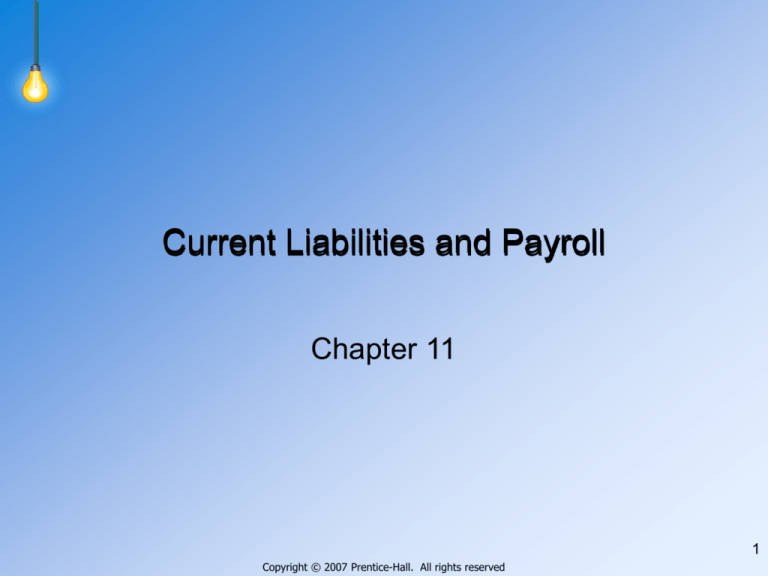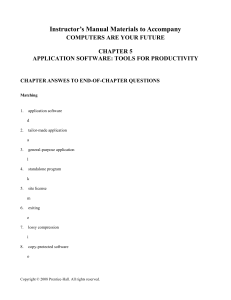
Current Liabilities and Payroll
Chapter 11
1
Copyright © 2007 Prentice-Hall. All rights reserved
Dina Company issued a 60-day note payable on
December 1. What adjusting entry should be
prepared on December 31?
1.
2.
3.
4.
Debit cash, credit note payable
Debit interest expense, credit note payable
Debit interest expense, credit interest payable
Debit interest payable, credit interest expense
2
Copyright © 2007 Prentice-Hall. All rights reserved
Answer: 3
3
Copyright © 2007 Prentice-Hall. All rights reserved
Emmett Company has a year-end of December 31
and issued a 60-day note payable on December 1.
The entry to record the payment of the note in
January would include
1. A debit to interest payable
2. A credit to note payable
3. A debit to cash
4. A credit to interest expense
4
Copyright © 2007 Prentice-Hall. All rights reserved
Answer: 1
5
Copyright © 2007 Prentice-Hall. All rights reserved
The adjusted trial balance for Young Company has
the following liabilities:
Accounts payable
$1,000
Interest payable
500
Notes Payable
$5,000
The notes payable requires monthly principal
payments of $100. What is the amount of total
current liabilities?
6
Copyright © 2007 Prentice-Hall. All rights reserved
Answer: Current liabilities
Accounts payable
Interest payable
Currently maturing portion of
Notes Payable ($100 X 12)
Total
$1,000
500
1,200
$2,700
The rest of the notes payable is reported under
long-term liabilities.
7
Copyright © 2007 Prentice-Hall. All rights reserved
On Sept. 1, Revale Company collected $600 for six
months’ rent in advance. The $600 was credited to
Unearned Rent. What is the December 31 adjusting entry?
1.
2.
3.
4.
Debit Cash $600, credit Unearned Rent $600
Debit Rent Receivable $600, credit Rent Revenue $600
Debit Unearned Rent $400, credit Rent Revenue $400
Debit Rent Receivable $400, credit Rent Revenue $400
8
Copyright © 2007 Prentice-Hall. All rights reserved
Answer: 3
Rent revenue for four months = $400
9
Copyright © 2007 Prentice-Hall. All rights reserved
Warranty expense should be recorded:
1.
2.
3.
4.
In the period when the warranty claims are paid
In the period when the sale was recorded
On the day of the sale
When the warranty period expires
10
Copyright © 2007 Prentice-Hall. All rights reserved
Answer: 2 The matching principle dictates that
the expenses related to a sale be recognized in
the same accounting period as the sale.
11
Copyright © 2007 Prentice-Hall. All rights reserved
When recording Warranty Expense, what account
is credited?
1.
2.
3.
4.
Cash
Sales
Estimated Warranty Revenue
Estimated Warranty Payable
12
Copyright © 2007 Prentice-Hall. All rights reserved
Answer: 4
13
Copyright © 2007 Prentice-Hall. All rights reserved
When it is reasonably possible that a contingent
liability will result in a realized loss, how is it
reported?
1. It is not reported
2. Describe the situation in a note to the financial
statements
3. Record an expense and liability based on
estimated amounts
14
Copyright © 2007 Prentice-Hall. All rights reserved
Answer: 2
15
Copyright © 2007 Prentice-Hall. All rights reserved
Which of the following is not a required payroll
deduction?
1. Employee income tax
2. FICA old age, survivors’, and disability
insurance tax
3. FICA medicare tax
4. Pension contribution
16
Copyright © 2007 Prentice-Hall. All rights reserved
Answer: 4
17
Copyright © 2007 Prentice-Hall. All rights reserved
The employer pays all of the following payroll
taxes except:
1.
2.
3.
4.
FICA tax
State unemployment tax
Income tax
Federal unemployment tax
18
Copyright © 2007 Prentice-Hall. All rights reserved
Answer: 3
Income tax is withheld from the employee’s
paycheck. It is not a tax paid by the employer.
19
Copyright © 2007 Prentice-Hall. All rights reserved
Which of these taxes has no maximum annual
tax?
1. FICA old age, survivors’, and disability
insurance tax
2. FICA medicare tax
3. Federal unemployment tax
4. State unemployment tax
20
Copyright © 2007 Prentice-Hall. All rights reserved
Answer: 2
21
Copyright © 2007 Prentice-Hall. All rights reserved
22
Copyright © 2007 Prentice-Hall. All rights reserved










